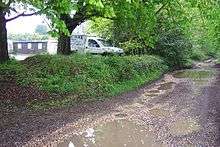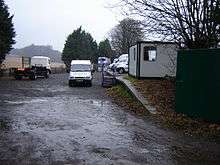Basingstoke and Alton Light Railway
The Basingstoke and Alton Light Railway was a standard gauge railway in Hampshire, UK. The 12 mi (19 km) line, which opened on Saturday, 1 June 1901 with no formal ceremony,[1] ran between Basingstoke and Alton. It was the first railway authorised by the Light Railway Commission to be built under the Light Railways Act 1896.
| Basingstoke and Alton Light Railway | |
|---|---|
 Section of vintage track representing the Basingstoke and Alton Light Railway, on the Viables Roundabout in Basingstoke. | |
| Overview | |
| Type | Light rail |
| Locale | Basingstoke Hampshire |
| Operation | |
| Opened | 1901 |
| Closed | January 1917, reopened August 1924, final closure 12 September 1932 |
| Owner | London and South Western Railway Southern Railway |
| Operator(s) | London and South Western Railway Southern Railway |
| Technical | |
| Track gauge | 4 ft 8 1⁄2 in |
In January 1917 much of the track was removed. But the line was relaid and re-opened in August 1924 largely because of pressure from local landowners, farmers and agricultural workers. Passenger services ended in 1932 but a goods service from Basingstoke as far as Bentworth and Lasham continued until 1936. Most of the line was then lifted for a second time. However, two short stretches of track at either end of the railway were left in place. These were used for shunting goods traffic until 1967. The northern section was from Basingstoke to the Thornycroft factory, and from Butts Junction to Alton Park at the southern end.
Construction
The line was authorised under the Light Railways Act in December 1897. Construction began in July 1898. As the first light railway in the country the construction attracted some interest in the railway industry and the first cut in the ground was ceremonially made by Charles Ritchie, the then President of the Board of Trade at a spot next to the Thornycroft works near Basingstoke.
Route
| Basingstoke & Alton Light Railway | ||||||||||||||||||||||||||||||||||||||||||||||||||||||||||||||||||||||||||||||||||||||||||||||||||||||||
|---|---|---|---|---|---|---|---|---|---|---|---|---|---|---|---|---|---|---|---|---|---|---|---|---|---|---|---|---|---|---|---|---|---|---|---|---|---|---|---|---|---|---|---|---|---|---|---|---|---|---|---|---|---|---|---|---|---|---|---|---|---|---|---|---|---|---|---|---|---|---|---|---|---|---|---|---|---|---|---|---|---|---|---|---|---|---|---|---|---|---|---|---|---|---|---|---|---|---|---|---|---|---|---|---|
| ||||||||||||||||||||||||||||||||||||||||||||||||||||||||||||||||||||||||||||||||||||||||||||||||||||||||
The railway operated from Basingstoke railway station, through Cliddesden, Herriard and Bentworth and Lasham to Butts Junction (just west of Alton). In 1909 a private platform was opened called Alton Park, also Treloar's Hospital Platform railway station, which served the Lord Mayor Treloar's hospital.
Operation
Excluding the approach to Butts Junction, the line was entirely single track. Only Herriard station was provided with two platforms. As a light railway, the line had an overall speed limit of 25 miles per hour, and the journey from Basingstoke to Butts Junction took typically 45 minutes. When it opened, there were three return trips to Alton daily, which rose to six by the summer of 1909, with an extra couple of goods trains.
Filming
The railway was used for the filming of the 1929 film The Wrecker and the 1937 film Oh, Mr Porter! which features Cliddesden station as the fictional Buggleskelly. [3] Unused footage from The Wrecker was used in the 1936 film The Seven Sinners.[4]
Commemoration
A short length of railway track was installed in the centre of the Viables roundabout in Basingstoke in 1976 to commemorate the line at a point close to its original route. There is also a plaque at the main station in Basingstoke. The only part of the railway which survives today is a 100m stub of track 1 mile west of the railway station in Basingstoke.
Gallery
 The site of Herriard railway station.
The site of Herriard railway station. The remains of Bentworth and Lasham railway station.
The remains of Bentworth and Lasham railway station.
References
- Griffith, Edward (1982). The Basingstoke & Alton Light Railway. Kingfisher Railway Productions.
- BBC - Hampshire - Alton line's silent movie stunt, 26 November 2009
- "Spectacular crash". Heritage Railway (132, 22 December 2009 – 20 January 2010): 25.